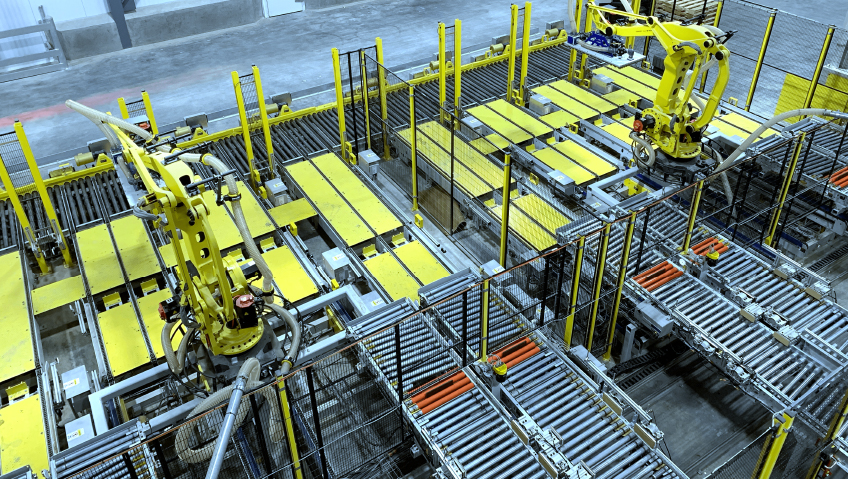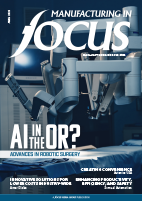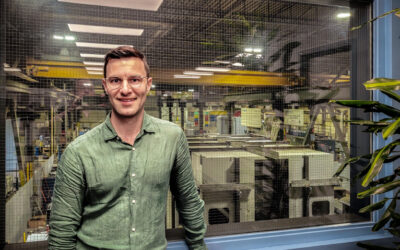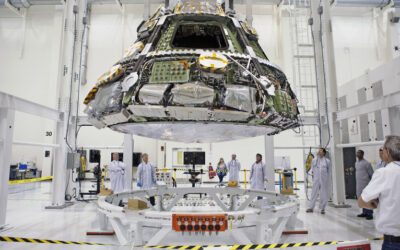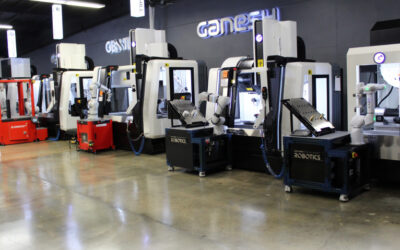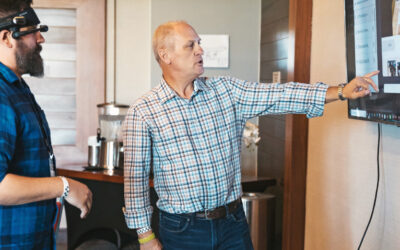Adaptec Solutions is a full-service provider of automation and material handling solutions with lifecycle service capabilities. Adaptec increases the productivity and profitability of its customers with an integrated system of analytics and connectivity, tracking and diagnosing equipment performance, making the process of resolving operational complexity far simpler.
With expertise in material handling and lifecycle services, combined with industrial, warehousing, and packaging automation, Adaptec provides exceptional support for automation, robotic, and material handling equipment. This is largely due to the company’s full-service integration capabilities to handle concept design all the way through engineering, assembly, testing, installation, start up, and aftermarket support.
Adaptec recently celebrated its 45-year anniversary—a gratifying milestone for a company built on putting its customers’ needs first.
“Over the years,” says partner and Executive of Lifecycle Services, Bob Manion, “we’ve gone from expanding our company and portfolio into the automation side of the business. And then, over the last five to six years, we’ve gone through tremendous organic growth as well as the acquisition of three companies. We started as Aloi Materials Handling, acquired three companies, and quickly realized we needed to consolidate our company and create a single culture—‘One Adaptec.’”
One of the focus points ingrained into the Adaptec culture is the “white glove treatment,” listening to each customer’s initiatives and homing in on the right situation.
“It’s about being an integrator, picking and using party vendor relationships, and having direct access to partners in the business as well as leadership,” says James Van Thof, Vice President of Sales. “It’s really making sure the customer knows we’re putting them and their solution first, whether it’s a $2000 service project or a $10 million large-scale integration project. Putting them in the forefront is paramount to our success.”
The company’s longevity is impressive, especially given the challenges of COVID and the acquisitions freeze, he adds.
“It also shows our commitment to our customer, being a trusted partner and having customer retention,” says Manion. “That’s 45 years of growth, which is even more impressive than just 45 years in the business. It’s 45 years of continued growth and success, partnering with our customers.”
As with other industries, the pandemic recalibrated Adaptec’s ability to work remotely, especially in an industry that requires hands-on attention. This inspired engineers to become more effective and efficient while working with teams in a remote partnership. They had to be more diligent in designs and articulating in much more detail than before.
“We had a lot of our frontline workers and shop technicians out in the field keeping our customers running to continue moving the supply chain for essentials such as food and medical equipment,” says Van Thof. “We had a mix of office staff working remote and a mix of frontline workers that really were the heartbeat of our success in servicing customers during COVID. It enabled our customers to service their customers and get product out the door. It’s a testament to our people.”
Adaptec is known for its integration capabilities in automation, material handling, and warehousing / distribution solutions, but at the end of the day, it’s the “great people” that separate the company from others. Those that banded together through an unprecedented time to continue to operate the business and serve customers are a true exemplification of Adaptec.
The company’s core services are integrating end-to-end solutions from manufacturing to warehouse automation and material handling. The team has substantial experience in robotics, and with more than 1,000 robotic cells already installed across the United States, Adaptec integrates between 100 and 150 cells year over year.
Whether the industry or application is automotive, manufacturing, machine tending, forging, end-of-line palletizing, or packaging, Adaptec has a vast array of capabilities that sets it apart.
“Within the industry, we’re a unique company in size and scale,” says Van Thof. “We have the abilities and capabilities of the billion-dollar companies due to our service team of 150 technicians spread across the United States. We have service trucks able to answer calls within 15 to 20 minutes, but we also have that white glove touch on every project that is essential to our culture and DNA. This also allows us to maintain our excellence in robotics.”
Manion also adds that the true differentiators of Adaptec are its integration capabilities that can serve customers from concept design through installation, start up, and aftermarket services.
“It’s what we call lifecycle services and that’s truly unique. I think in the marketplace it doesn’t matter whether you’re a small or large multinational integrator, very few companies have all those capabilities in-house. We have the ability to service our customers 100 percent with our own capabilities, resources, and skill sets,” says Manion.
This dedication exemplifies Adaptec’s core mission and vision statement of “operational perfection.”
“Our customers come to us to help design, integrate, and service solutions that improve their efficiency in whatever environment they’re working in. They also come to us because they want to know how to operate the cells. We have the knowledge and capability to simplify that,” says Van Thof. “When we look at our mission, it’s operational perfection because that rings true for our customers. We’re taking the complex, simplifying it, and bringing it into reality for them.”
Adaptec’s products and innovations continue to evolve in the warehousing industry as the company continues to expand in its efforts to help customers be competitive, while getting the most efficiency and effectiveness in their automation. Adaptec’s software capabilities show the team is versed in manufacturing execution systems, tracking, and traceability.
“The warehouse control software is really critical because it becomes the nucleus of driving decisions from an automation standpoint,” says Van Thof. “That’s important for our continued success in robotic cells and conveyor systems, automated storage and retrieval systems, and palletizing and de-palletizing cells.”
Taking projects from raw material arriving on the production lines to products heading out the door to customers is made possible by Adaptec’s warehouse control software as well as its vast partnerships with multiple vendors in conveyance and in robotic cells.
Van Thof will give a presentation in November on what COVID has done to spike the interest in “robots as a service.”
As companies continue to onshore, and labor challenges become more difficult for customers to manage, Adaptec is using robots as a service to bridge the gap and give smaller customers the opportunity to have the advantages and the benefits of robotic cells.
“Essentially, you’re paying a robot like you pay an employee. You automate those tasks you can’t find labor for and repurpose the labor that you have to do the tasks that are most important to the organization,” says Van Thof.
This gives customers the flexibility to look at how they’re spending money, operationalize that spend versus a CapEx spend, and get the benefits of a robotic cell without necessarily adding headcount.
“Labor is a big challenge across our industry and our customer base—whether it’s food, manufacturing, automotive—you name it,” says Van Thof. “We’re trying to accommodate bringing robots to the masses so we can help solve customer challenges caused by labor shortage; not necessarily eliminating jobs but augmenting them and repurposing.”
When it comes to the belief that robots are replacing jobs in the industry, he considers the belief misguided.
“When you look at the data on robots, they’re not,” he says. “They’re actually providing additional high-paying jobs, servicing and maintaining those jobs, and training. It’s allowing our customers to be more competitive and nimbler, and to serve their customers by getting robots to do the trivial tasks that are hard to find labor for.”
Manion adds that Adaptec’s focus is also on its people. The company believes if it takes care of its people, the people will take care of its customers.
“It’s all about our employees and our customers,” he says. “Aside from labor shortages, COVID, and coming out of COVID, we also merged four companies together right through the middle of the pandemic and everybody had to figure out how to get to work and become an effective contributor primarily as a remote employee.”
Those are some big challenges, but the company thrived.
“That all comes down to the people,” says Manion. “We have a saying here that we are ‘One Adaptec,’ and if it wasn’t for our people—and quite frankly the leaders of our company that pull all our people together—we wouldn’t be One Adaptec. The foundational building blocks of our company have always been to take care of our employees and they’ll take care of our customers.”
Adaptec has certainly succeeded, navigating a series of upheavals and emerging victorious.
While the company isn’t immune to the supply chain challenges everyone is facing, a testament to its people is the creative workaround they’ve found, especially their ingenuity in creating solutions when some components aren’t available.
“Switching the design or process of how we’re going to meet the needs and timelines of our customers has been a real demonstration of the engineering capability and supply-chain management capability of our people. That’s what enabled us to hit projects on time and get them installed and implemented for our customers,” says Van Thof.
“None of that happens without our people who are putting in long hours,” adds Manion. “They’re creating solutions outside the box to dissolve challenges to really bring us to the next level.”
The next level also includes controlled growth, a milestone Adaptec is working toward as an organization. Growth is essential, but controlled growth allows the company to keep its people at the forefront so they’re not leaving customers behind or ignoring processes that need to be updated as they continue to upscale in size.
“We’ve added 70 people since the beginning of the year,” says Van Thof. “This has allowed us to mature the process and keep up with innovations in the marketplace, keep up with engineering practices, and make sure our projects are successful and delivered on time.” It’s a critical milestone, and, in fact, one of the top three objectives for the organization.
“I think we’re in a really good spot as an organization,” adds Van Thof. “We’re attracting extremely high-level talent. I would argue our company is in unprecedented territory in terms of the resumes and the people we’re seeing and hiring. The atmosphere and the culture are upbeat. We have people putting in long hours—and it’s their sense of urgency to service the customers—again it comes back to our people.”
Finding the right cultural fit and talent set is a challenge in itself, but the momentum Adaptec has in the marketplace and industry has made it easier to achieve.
“A lot of people are getting excited to talk to Adaptec, to come interview here, to do business here,” says Manion. “As an executive, it’s one of those things that is hard to measure, but when it happens it’s just a really cool experience to see things firing on all cylinders and having excitement around the organization, both internally and externally. It creates a fun environment and it’s exciting to come to work every day and put your best foot forward.”
Along with the company’s ability to consult with customers up-front on design, lean on its vast vendor relationships, and create the ultimate solution for the customer, Adaptec prides itself on its ability to home in on the right technology to ensure that it’s focused on the initiative for the customer.
Having the ability to service that technology after the fact is extremely important as well.
“When you look at our customer base, a lot of them have multiple facilities across the U.S. operating twenty-four-seven, and to have our service techs on-site to help troubleshoot and keep other systems running with an average return time of 15 minutes, is really that ‘white glove’ treatment we’re talking about,” says Van Thof. “It’s extremely important to who we are. It’s our business model constructs that really set us apart.”

